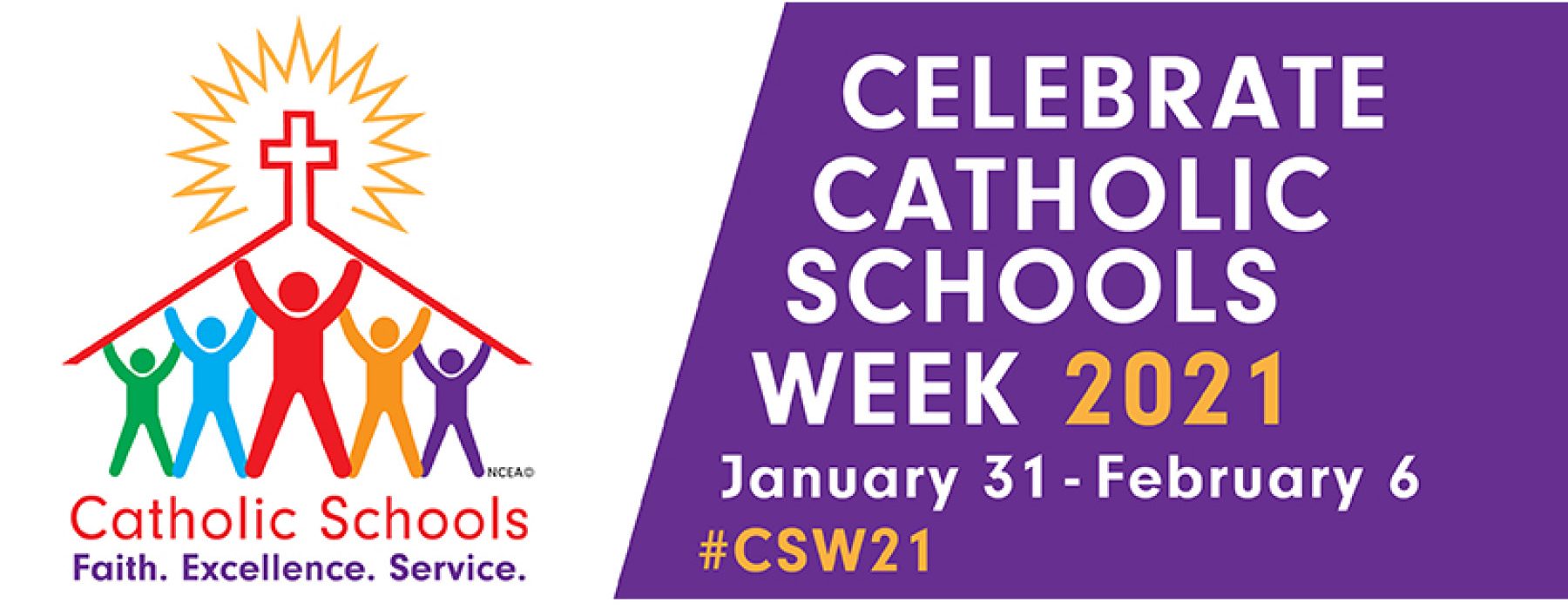January 27, 2021 // Diocese
Parents appreciate in-person learning — and having options
The four Zielinski children, who range from 6 to 18 years old, began attending Holy Family School, South Bend, as preschoolers. Kelley, their mother, said the school has always felt like home. “It’s small, we know all the families, the teachers are great, and many of them stay on year after year.”
When the pandemic hit last spring, Zielinski and her husband were grateful she could be a stay-at-home mom. Her older children did their schoolwork independently, but her younger two, who are both girls and in the first and third grades, needed more help.
“I have no complaints,” she said. “The teachers did the best they could. They communicated well with us parents, kept the children in touch with each other and made themselves available through flip grids whenever a student needed individual attention.”
At the decision point last summer, the Zielinskis felt it would be safer to keep their children at home. But they didn’t feel left out. They were in constant communication with Holy Family School, and they Zoomed in frequently to say hello to their classmates. When Kelley went to pick up materials for her at-home learners every Friday, she saw teachers taking students’ temperatures in the parking lot. She asked how things were going and always got positive responses.
“Principal Jennifer Veldman often said, ‘Whenever they’re ready to come back, that’s fine.’” By the end of the first quarter, Zielinski responded, “They’re ready.”
One was a little reluctant to give up her “mommy time,” but they all adjusted well,” said their mom. “Everything’s great with us at Holy Family.”
Anxious to return
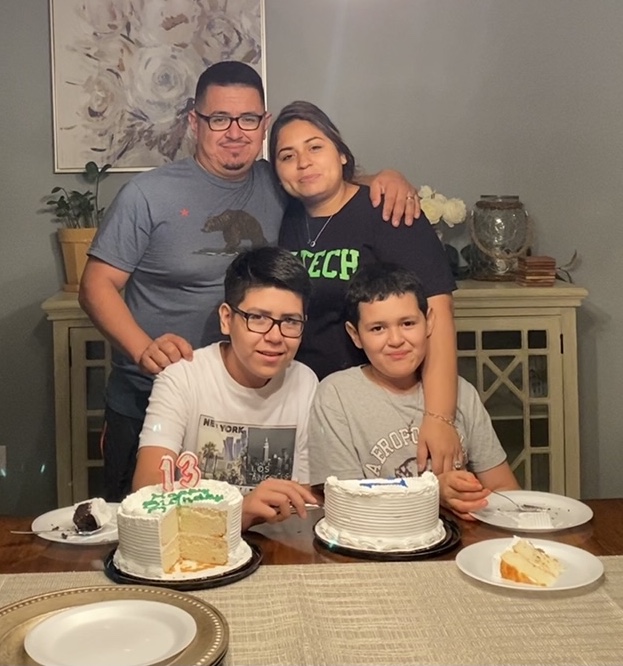
Anna Duron of South Bend is a St. Adalbert School parent who was glad to have her boys back in school this fall after being quarantined. From left are Anna and Omar Duron with, sons Omar Jr., 13, and Adan, 12.
When someone in the Duron house tested positive for COVID-19 in early November, the two Duron boys had to quarantine. Neither of them came down with the virus, but after two weeks of virtual learning, they were eager to get back to St. Adalbert. Now in sixth and eighth grades, they’ve attended the school since first and second grade and have grown up with their classmates, their mother, Anna, said.
“They really missed the interaction with their teachers and classmates,” she added.
Since Duron is able to work from home some of the time, she was able to juggle things to supervise their e-learning. “But they didn’t like me as a teacher,” she admitted.
“Virtual learning was fine, but I really believe in-person learning is better as far as education goes.”
No hesitation
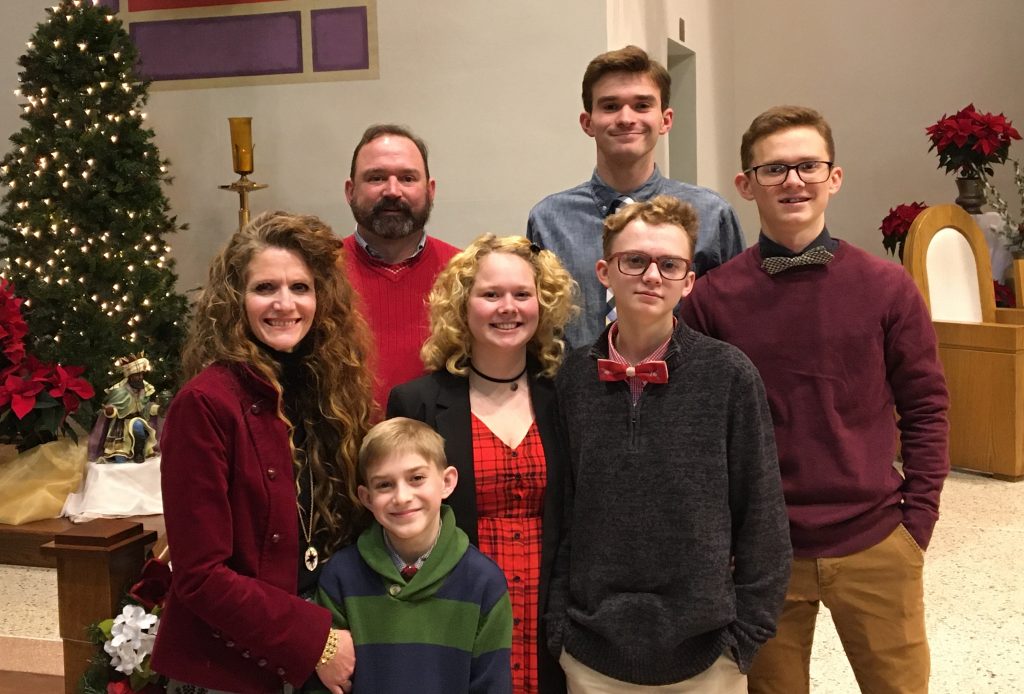
The Gernhardt family of Most Precious Blood School, Fort Wayne, adapted to virtual learning in the spring but were anxious to return to school in person in the fall.
When the novel coronavirus shut down everything last spring, Angela Gernhardt had a child in college, two at Bishop Luers High School in Fort Wayne and two at Most Precious Blood School. Suddenly, all five were learning at home.
“They’re all good students,” said their mom. “They all put themselves on a schedule, found a spot in the house to study and did great. Their teachers were very diligent, working hard to post their lessons. However, they all wanted to go to school in person this fall.”
Since one was an eighth grader and one a senior in high school last spring, they had to forego many of the usual end-of-year activities like graduation and confirmation. But their schools “went out of their way to make it special for them,” Gernhardt said.
Working in the school office, Gernhardt heard from many parents about students who were easily distracted and didn’t do very well learning virtually. Even though she’s blessed with children who can stay on task, she came to the conclusion that “kids learn better in person.”
Her husband works in a hospital, so the family is well aware of the dangers of COVID-19. “But we had no hesitation sending them back to school,” Gernhardt said. Both schools have safety protocols in place that have worked well.
Virtual struggles
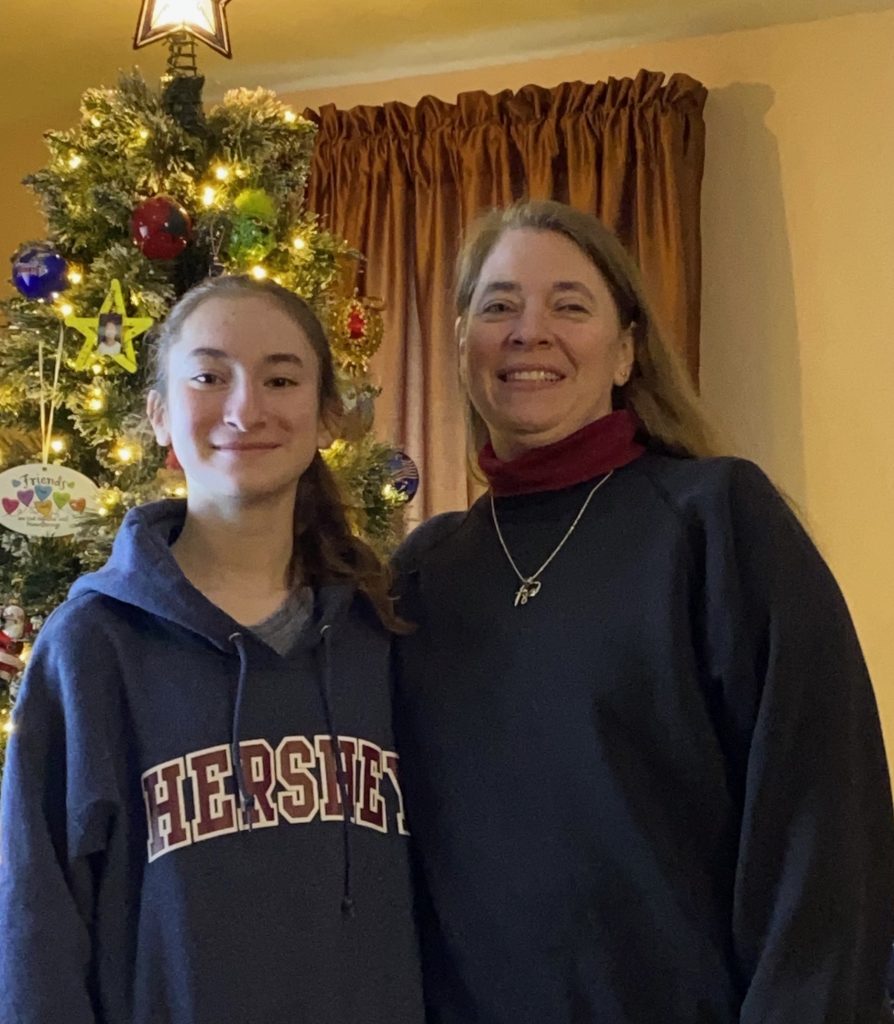
While schools in the diocese have fine-tuned their remote learning processes since the start of the pandemic, some students, like Jorja Ramos, left, a freshman at Bishop Luers, say parts of it didn’t work well for them. Mom Lisa Ramos is at right.
Jorja Ramos was in the eighth grade at St. Elizabeth Ann Seton School, Fort Wayne, last spring. Her mother, Lisa, said learning at home was “kind of OK,” but that Jorja struggled with algebra. Because the class wasn’t able to Zoom, the teacher couldn’t see her students’ faces to know when they weren’t getting it, Ramos said, and Jorja also found it stressful to have all her assignments post at once instead of coming her way one at a time.
When school began this fall, Ramos had no hesitation about sending her daughter to her new school, Bishop Luers.
“She’s doing great. I feel strongly that it’s much better for her to be able to interact with her teachers and classmates in person, especially in a setting that’s new to her. I’m thankful Luers has been able to stay open most of the time.”
A learning curve for everyone
When the pandemic began, Angela Arambula’s daughter Amelia was in kindergarten at St. John the Baptist School in Fort Wayne.
“St. John’s never even had remote learning as an option for snow days,” she said. “Suddenly, everyone had to figure it out. The teachers worked their tails off. It was such a blessing!”
Because another household member is medically vulnerable, Arambula was happy to have the children at home instead of risking their bringing COVID-19 home. That’s why Amelia also began this school year at home.
Bishop Luers, where Arianna and Karson Arambula go to school, made the shift to virtual learning more easily last spring. When it came time to decide about this school year, Karson wanted to stay home but Arianna opted for in-person learning. Interestingly enough, she is now learning remotely while Karson is attending in-person at Bishop Luers.
“You have to weigh it all out carefully,” explained their mom. “You have to decide what works best for your family and for each child. Everyone’s circumstances are different.”
On her first day back to Bishop Luers, Arianna was exposed to someone awaiting test results for the virus. That meant she had to quarantine for two weeks. Even though she eventually tested negative, at the end of those two weeks, she decided to keep learning remotely, as most of her friends were doing. An excellent student, that style of learning works well for her.
Karson has an Individual Services Plan. His learning challenges made it more difficult for him to learn virtually.
“He needed more resources than I could give him,” said Arambula. He’s been doing much better since he returned to Bishop Luers in person at the end of September, she noted. However, he follows a strict protocol when he gets home from school, immediately wiping everything down, showering and putting his school clothes in the washing machine. “That seems to be a good game plan,” said Arambula. “We haven’t been sick at all.”
Amelia was the only first grade student at St. John the Baptist whose parents chose to keep her at home, but her teacher worked hard to keep her connected with her class, recording daily videos just for her. However, her mother began to feel Amelia needed more help learning to read. “After all,” she said, “who wants her mom to be her teacher? That’s not what I was trained to do.”
St. John the Baptist had worked hard to make in-person learning safe, she said, dividing the first graders into two separate classes of 14 students each to facilitate distancing. So the Arambulas felt safe sending Amelia back in October. She was happy to be with her friends, her mother said, and her learning has accelerated.
“All my children have phenomenal teachers,” Arambula testified. “They give 150%. We love Catholic schools!”
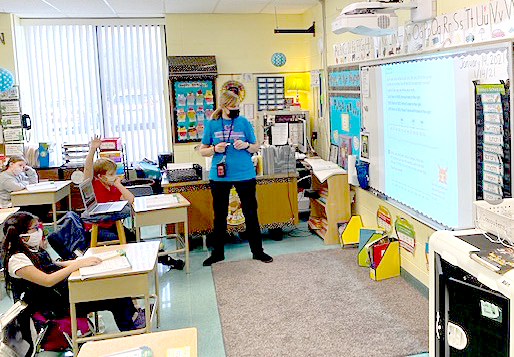
Provided by Rob Sordelet
While schools in the Diocese of Fort Wayne-South Bend have developed and fine-tuned their remote learning processes since the start of the pandemic, many students were anxious to return to in-person, classroom learning, like these students at St. Charles Borromeo School, Fort Wayne.
New tools in the learning toolbox
Angelica Duarte’s four children have gone through parochial schools; currently, Jossie is a junior at Saint Joseph High School, South Bend; Gaby in junior high at St. Adalbert.
“I wanted them to go in person if at all possible,” said their mother. “I just believe it’s a lot better for the children.”
In her work as the Latino liaison at Saint Joseph, Duarte has observed students’ grades drop when they can’t be in school. It’s especially difficult for these students, whose parents may not have sufficient time or mastery of English to reach out to teachers or to help their children stay on track, she said.
Even though Duarte is able to support her children as they learn, she insisted they attend school in person. Jossie was apprehensive because of the virus, but at the end of her first day she told her mother, “I’m so glad you made me go.”
For the first month of this school year at St. Adalbert, half the students attended in the morning, the other half in the afternoon; each cohort learned virtually during the half-day they weren’t in school. Besides better social distancing, this gave the school a chance to practice its protocols.
“Our teachers and students have done a fantastic job of adapting to remote learning, via Google Classroom,” said principal Joseph Miller. “But our plan is to continue in-person instruction as long as we are able.
“Ours is an incarnational faith. Jesus did not Zoom in. He took on flesh. So being with each other, and even taking on risk — though never in a reckless way — seems consistent with Jesus’ way.”
The best news. Delivered to your inbox.
Subscribe to our mailing list today.






